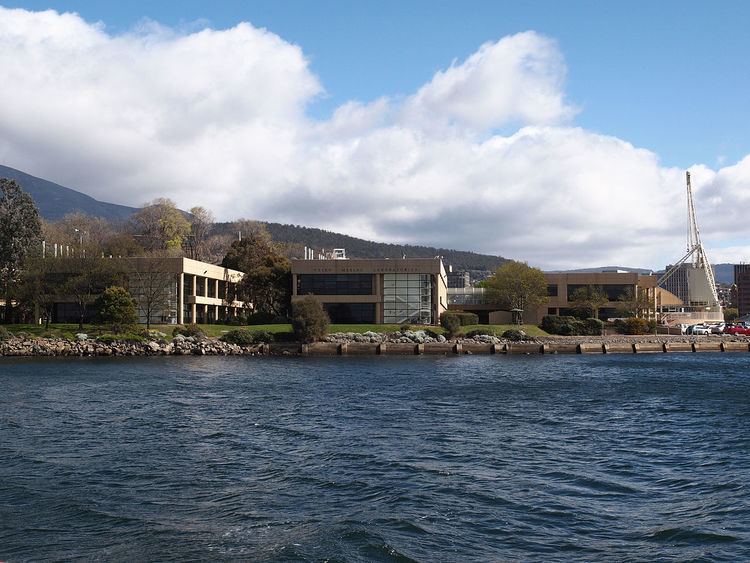 | ||
CSIRO Oceans and Atmosphere (O&A) is one of the current 8 Business Units (formerly: Flagships) of the Commonwealth Scientific and Industrial Research Organisation (CSIRO), Australia's largest government-supported science research agency.
Contents
History
The CSIRO Oceans and Atmosphere (O&A) Business Unit was formed in 2014 as one of the then 10 "Flagship" operational units of the Commonwealth Scientific and Industrial Research Organisation (CSIRO) as part of a major organisational restructure; from 2015 onwards the term "Flagship" was officially dropped. This Business Unit was formed essentially as a synthesis of the pre-existing CSIRO Division of Marine and Atmospheric Research (CMAR), representing the scientific capability, and the previously established Wealth from Oceans (WfO) Flagship, which was the route via which much of the relevant Australian government research funding was directed. As at 2016, its Director is Dr. Ken Lee, previously WfO Flagship Director. The O&A Business Unit currently employs between 350 and 400 staff who are located at its various laboratories including Hobart (Tasmania), Aspendale (Victoria), Dutton Park (Queensland), Black Mountain (Canberra) and Floreat Park (Western Australia). For 2016 it was quoted as operating with an annual budget of $108M Australian Dollars with its research organised into the following the following programs: Climate Science Centre; Coastal Development and Management; Earth System Assessment; Engineering and Technology; Marine Resources and Industries; and Ocean and Climate Dynamics. Certain previous CMAR activities, notably those involving the operation of the Marine National Facility (research vessel) RV Investigator and certain scientific collections, are now managed within the separate CSIRO National Facilities and Collections Program.
The previous CSIRO Division of Marine and Atmospheric Research was itself formed as a result of a 2005 merger between the former CSIRO Division of Marine Research, with laboratories in Hobart, Brisbane, and Perth, and CSIRO Division of Atmospheric Research, with laboratories in Aspendale and Canberra; the Division of Marine Research was itself formed in 1997 as a merger between two previous CSIRO Divisions, the Division of Fisheries Research and the Division of Oceanography, both with their headquarters in Hobart. Additional details of the somewhat convoluted organisational history of the relevant Divisions and their predecessors is available here.
Seagoing capabilities
Through the 1980s and 1990s the marine Divisions of CSIRO had the use of both the RV Southern Surveyor, equipped for biological as well as oceanographic research, and the purpose built RV Franklin for physical and chemical oceanographic research, both of which served at various times as the Marine National Facility for the nation (meaning that other agencies could also carry out research using these vessels at what was effectively a subsidised rate by the Australian government). The last of the vessels to be retired, the Southern Surveyor, was replaced in 2014 by a new purpose built research vessel to serve as the Marine National Facility, the RV Investigator. Coupled with these major vessels, all capable of significant ocean-going research expeditions, staff were able to use a range of smaller boats and sometimes, charter vessels to carry out research in a range of coastal waters.
2016 Climate Science cuts controversy and subsequent partial restoration
In February 2016 the chief executive of CSIRO, Dr Larry Marshall, announced that research into the fundamentals of climate science was no longer a priority for CSIRO and up to 110 jobs were feared to be cut from the climate research section(s) of the Oceans and Atmosphere Unit. After overwhelming negative reaction both within Australia and overseas, along with the forced redundancy of prominent climate scientists including the internationally renowned sea level expert Dr John Church, the Australian Government intervened with a directive and promise of new money to support the restoration of 15 jobs and the creation of a new Climate Science Centre to be based in Hobart with a staff of 40, with funding guaranteed for 10 years from 2016, although the expected number of job losses for O&A was still estimated at 75. While the establishment of the new Centre was described as a "major U-turn in the direction of the CSIRO" and a win for the Turnbull government over the previous CSIRO announcement, the generally positive reaction from other scientists was qualified by the fact that the new Centre would still represent a net loss to CSIRO's previous capability in this area. A more detailed account of this episode is available elsewhere on Wikipedia here.
Selected notable scientists associated with O&A and its predecessors
Books on CSIRO's marine research activities
CSIRO At Sea, a "popular" account of the early research activities of the marine components of the relevant CSIRO Divisions (former Divisions of Fisheries, Fisheries and Oceanography, Oceanography, and Fisheries Research) was published in 1988, a few years after the relocation of the majority of CSIRO's marine research activities to Hobart from Cronulla, New South Wales.
